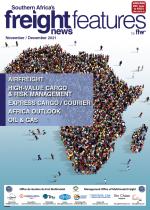A report on the state of climate risk regulation in Africa’s financial industry, launched by the African Financial Alliance on Climate Change (Afac) at COP26, makes it clear that climate change could make logistics in Africa even more challenging than it is currently – both physically and financially.According to the Global Climate Risk Index 2021, five African countries ranked among the 10 countries most affected by extreme weather in 2019: Mozambique (first), Zimbabwe (second), Malawi (fifth), South Sudan (eighth), and Niger (ninth).A joint publication by the African Development Bank, the Global Center on Adaptation, and the UN Environment Finance Initiative, titled “Climate risk regulation in Africa’s financial industry and related private sector initiatives”, identifies some of the related financial risks likely to affect companies doing business in Africa.“Extreme weather events could lead to damage of physical assets, including real estate, productive capital, and infrastructure, consequent property and casualty insurance losses, damage to balance sheets of households and firms, increases in defaults, and potential financial sector distress,” it states.Speaking at the publication of the report, Anthony Nyong, regional director of the Global Center on Adaptation, Africa, warned that “49 banks in Africa have over $200 billion in lending across sectors with high-potential climate risks”.The Financial Sector Development Department of the African Development Bank is developing the Africa Financial Sector Corporate Governance initiative to provide technical assistance to banks and regulators in building their capacity to identify, assess and manage climate risks.“African banks are vulnerable to the increasing frequency and severity of climate change shocks unless regulators and lenders take action to mainstream these risks into their regulations and operations.“By strengthening their capacity, banks will be able to build quality portfolios and mobilise climate funding, thereby increasing the f low of capital for adaptation as well as mitigation,” said Sofiane Sekioua, chief investment officer at the Bank.Global warming also creates opportunities.Kevin Kariuki, vice-president for power, energy, climate and green growth at the African Development Bank, said during a panel discussion on the challenges that “global alliances making net-zero pledges represent a large pool of liquidity, and as their membership grows, they will be looking for new frontiers for green investments.“Africa has the natural assets needed to get to net-zero. To close the loop, the African financial sector has a catalytic de-risking role to crowd in external capital.”The African Development Bank says it will deploy resources within the framework of its ten-year Climate Change and Green Growth Strategy (2021-2030) to position Africa’s financial industry at the forefront of the low-carbon and climate-resilient transition.South African financial institutions have been strategising and planning for climate change risks since 2015, when the Banking Association of South Africa published ‘Principles on Environmental and Social Risk Ma nagement ’.In 2017 the National Treasury convened a working group to develop a Green Finance Taxonomy and governance framework.In 2021, a Sustainable Finance Working Group established under SA’s Climate Risk Forum to develop norms and standards for sustainable finance instruments, and the South African Reserve Bank conducted a physical climate risk exercise.

